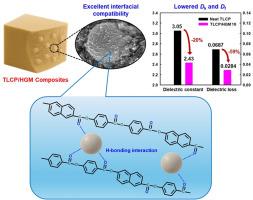中空玻璃微球增强低介电疏水性热致液晶聚酯复合材料,用于下一代电子电路板材料
IF 9.8
1区 材料科学
Q1 MATERIALS SCIENCE, COMPOSITES
引用次数: 0
摘要
在本研究中,通过母粒稀释的熔融复合技术制备了基于热致液晶聚合物(TLCP)并加入中空玻璃微球(HGM)的复合材料,随后通过注塑成型。研究了HGM (2-10 wt%)对复合材料的微观结构、热行为、流变力学性能、介电性能和疏水性的影响。电镜和红外光谱证实了HGM的均匀分散和与TLCP基体的强界面氢键。x射线衍射显示HGM破坏了TLCP的结晶度,而差示扫描量热法显示随着填料含量的增加,结晶和熔化温度降低。热重分析表明,TLCP/HGM10的炭产率由纯TLCP的38.2%提高到48.8%。流变学测试表明熔体粘度和粘弹性模量增强,动态力学分析表明链迁移率受限,玻璃化转变温度升高。重要的是,与纯TLCP相比,TLCP/HGM10在2 MHz时的介电常数(Dk ~ 2.43)和损耗(Df ~ 0.0284)分别降低了约20%和59%,这些实验值与基于Maxwell-Garnett模型的理论预测具有良好的相关性。水接触角试验进一步表明,添加HGM后,表面疏水性从77.4°提高到88.8°。这些结果共同表明,HGM的加入同时增强了TLCP复合材料的热、介电和防潮特性,使其成为高频和湿弹性电子应用的有希望的候选者。本文章由计算机程序翻译,如有差异,请以英文原文为准。

Low-dielectric and hydrophobic thermotropic liquid crystalline polyester composites reinforced with hollow glass microspheres for next-generation electronic board materials
In this study, composites based on thermotropic liquid crystalline polymers (TLCP) and incorporated with hollow glass microspheres (HGM) were prepared via a melt compounding technique facilitated by masterbatch dilution, followed by subsequent shaping through injection molding. The influence of HGM loading (2–10 wt%) on the microstructure, thermal behavior, rheological and mechanical properties, dielectric performance, and hydrophobicity of the composites was comprehensively investigated. Electron microscopy and infrared spectroscopy confirmed uniform dispersion of HGM and strong interfacial hydrogen bonding with the TLCP matrix. X-ray diffraction revealed that HGM disrupts TLCP crystallinity, while differential scanning calorimetry demonstrated a decrease in crystallization and melting temperatures with increasing filler content. Thermogravimetric analysis showed excellent thermal stability, with char yields increasing from 38.2 % for neat TLCP to 48.8 % for TLCP/HGM10. Rheological testing revealed enhanced melt viscosity and viscoelastic moduli, and dynamic mechanical analysis indicated restricted chain mobility and increased glass transition temperatures. Importantly, the dielectric constant (Dk ∼2.43) and loss (Df ∼0.0284) at 2 MHz decreased by approximately 20 % and 59 %, respectively, for TLCP/HGM10 compared to neat TLCP, and these experimental values correlated well with theoretical predictions based on the Maxwell-Garnett model. Water contact angle tests further showed improved surface hydrophobicity, increasing from 77.4° to 88.8° with HGM addition. These results collectively demonstrate that the incorporation of HGM simultaneously enhances the thermal, dielectric, and moisture-resistance characteristics of TLCP composites, making them promising candidates for high-frequency and moisture-resilient electronic applications.
求助全文
通过发布文献求助,成功后即可免费获取论文全文。
去求助
来源期刊

Composites Science and Technology
工程技术-材料科学:复合
CiteScore
16.20
自引率
9.90%
发文量
611
审稿时长
33 days
期刊介绍:
Composites Science and Technology publishes refereed original articles on the fundamental and applied science of engineering composites. The focus of this journal is on polymeric matrix composites with reinforcements/fillers ranging from nano- to macro-scale. CSTE encourages manuscripts reporting unique, innovative contributions to the physics, chemistry, materials science and applied mechanics aspects of advanced composites.
Besides traditional fiber reinforced composites, novel composites with significant potential for engineering applications are encouraged.
 求助内容:
求助内容: 应助结果提醒方式:
应助结果提醒方式:


